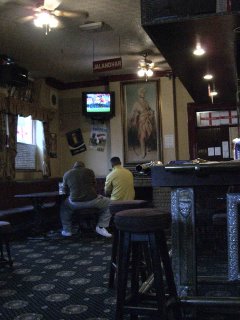ENGLAND v Sweden
 It would be a shame to conduct such a rigorous academic study of multicultural London as this without including one of the city’s largest communities. But it’s not my fault that the Indian national team is the international equivalent of Cowdenbeath, not even making it to the final Asian qualification stage alongside such greats of the game as Kuwait and North Korea.
It would be a shame to conduct such a rigorous academic study of multicultural London as this without including one of the city’s largest communities. But it’s not my fault that the Indian national team is the international equivalent of Cowdenbeath, not even making it to the final Asian qualification stage alongside such greats of the game as Kuwait and North Korea.But London’s Indian community is so well established that I knew very well that many first, second and third-generation Indian Londoners would be supporting England as passionately as the next man or woman. So there was only one place to go: London’s least white – by far – area: Southall, where only 8.7% of people consider themselves White British. And it was just up the road.
And as I made my way past the legendary Himalaya Palace cinema to the Sikh pub I had been recommended, I was glad to see quite a few of the local Indian motorists were sporting the familiar car-based England flags.
But, 10 minutes before kick-off, the pub was less busy than I’d hoped. I was consoled by the excellent décor: it was a great blend of Indian and British, as glitzy as yesterday’s Saudi venue but ten times less tasteless. There were paintings of Indian princes, copious gilt-framing (including the gilt-framed big screen on which the national anthems were currently being played), a mosaic mirrored bar and back-lit scenes of Indian village life, all housed in a traditional boozer, right down to the vintage Guinness adverts; and of course, with the St George’s Crosses up for the World Cup. And they had Kingfisher on tap!
As the match got underway the pub started to fill up, with some of my neighbours also expressing surprise that it wasn’t busier. But England were already guaranteed a place in the second round.
The crowd was a decent size, although not huge; but they were not lacking any commitment, indulging in the familiar Rooney chants when the boy wonder burst through towards goal; passionately discussing all the footie issues as the game went on; and celebrating loudly when Joe Cole struck a contender for goal of the tournament.
At half-time I noticed that the signs on the toilet doors were in a language I didn’t understand (or recognise). I worried about committing a huge faux pas, but then realised that, just like there were no other white faces in the pub, there were no female faces of any persuasion. So I wasn’t going to have a chance to come across Parminder Nagra touching up her make-up in the ladies. She was probably too busy saving lives in Chicago anyway.
For the first time in the tournament, Sweden tore into their opponents after the break. There was dejection when they equalised, but the positive atmosphere remained, even as the Swedes lay siege to England’s goal. I wondered if this relaxed atmosphere was a specific characteristic of Indian England fans, but my most glamorous mole later told me that it had been the same where she was watching it. It was probably more to do with England already having qualified for the second round. I gave up trying to identify any specific characteristics of Indian England fans.
Huge cheers went up when it looked like Steven Gerrard’s late goal had earned England all three points, and there was despair when Henrik Larsson equalised in the last minute. But not too much despair: England had done enough to win the group and would avoid Germany in the next round.
I made my way to the station, struggling to resist the tempting smells of the local food vendors.

<< Home